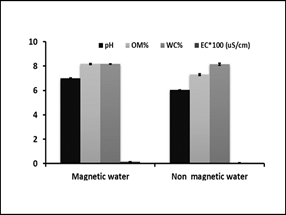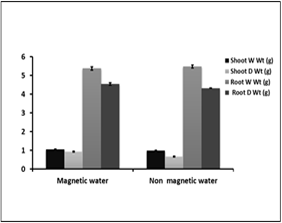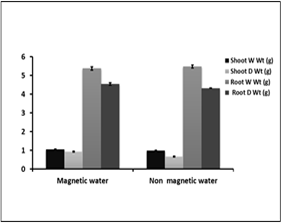


The Effect of Magnetic Water on Soil Characteristics and Raphanus sativus L. Growth
Amal Ahmed Mohammed Al-Ghamdi
Department of Biological Sciences, Faculty of Science, King Abdulaziz University, Jeddah, Saudi Arabia.
Abstract
Magnetic field treatment is considered a safe and cost-effective method of increasing seed germination and emergence. Previous research has demonstrated that water irrigated with magnetic fields affects plant parameters, such as seed germination, root and seedling growth, chlorophyll content, and meristematic cell growth. An experiment was conducted in greenhouse conditions to find the most favourable treatment for obtaining high-value plants and investigate the effect of magnetic water on radish plant growth and soil characteristics. The plants were harvested after 12 weeks. The results revealed that plants irrigated with magnetised water had the highest plant height, stem length, and root length, as well as fresh and dry weight of root and shoot systems. Additionally, Raphanus sativus irrigated with magnetised water achieved better physical soil properties than those treated with non-magnetised water. Overall, the use of magnetically treated water in irrigation can be considered one of the most valuable modern technologies to help improve the quality and quantity of yield. Further investigations of the effect of magnetised water in agriculture are warranted because it is a potentially beneficial technology.
Keywords: magnetised water; non-magnetised water; Raphanus sativus; soil pH; soil organic carbon
At present, agriculturalists worldwide are seeking to develop environmental-friendly technologies based on physical and biological treatments to augment crop yields (Vashisth and Nagarajan, 2010). Investigators have concluded that the use of magnetised water—that is, water that has passed through a magnetic field or device—in irrigation systems is an ecologically friendly and safe technology, and its application should be recommended in agriculture, specifically as a dormancy-breaking treatment (Yao et al., 2015).
Magnetic field treatment is considered a safe and cost-effective method of increasing seed germination and emergence (Payez et al., 2013). Previous research has demonstrated that water irrigated with magnetic fields affects plant parameters, such as seed germination, root and seedling growth, chlorophyll content, and meristematic cell growth (Manzano et al., 2013). In addition, magnetic water improved the movement of nutrients in the soil and plant uptake of Pb, K, and Zn (Ghanati et al., 2015). Another effect of magnetic water is its ability to increase water absorption from soil and fertiliser efficacy. Other investigators reported that magnetised water in saline irrigation water efficiently caused soil desalinisation.
Previously, researchers investigated the effect of fertilisers to improve the growth and yield of Raphanus sativus L. (Zeb et al., 2016). This plant is used in some areas for the treatment of gastrointestinal diseases (Shukla et al., 2011) and as an anti-neoplastic, antimicrobial, and antiviral agent (Manivannan et al., 2019). The main aim of this work was to investigate the effect of magnetised water on the germination, morphological characteristics, and biochemical analysis of R. sativus.
Germination experiment
Ten seeds from R. sativus were placed in Petri dishes with two layers of Whatman No.1 filter paper. Replication was performed three times. Three millilitres of water were added into the petri dishes. Then, another 3 ml of the treated liquid was added to the individual dishes. The Petri dishes were observed daily for 7 days and equal amounts of water and magnetic water were poured into each petri dish as needed. Information about germination was documented daily for 7 days.
Characterisation of soil physiochemical properties
Approximately 3 kg of the soil on which the R. sativus plants were cultivated was collected. The pH of the soil was determined (soil-to-water ratio, 1:2) with the help of a pH meter (PH-meter, STARTER 3100C, OHAUS) (Conklin 2005). The soil’s electrical conductivity was measured using an EC-meter (EC-meter, STARTER 3100C, OHAUS). The soil’s percentage of moisture and organic carbon were measured using the method described by Wilde et al. (1972). Using previously described procedures (Conklin, 2005), the soil and plant specimens were examined for their organic carbon and water content. Standard procedures were utilised to measure the macroelements and microelements in the soil specimens (Dewis and Freitas, 1970) using inductively coupled plasma emission spectrometry (Model Optima 8000, PerkinElmer).
Measurement of pH and electrical conductivity
The pH of ordinary and magnetic water was measured separately using a pH-meter (PH-meter, Mettler Toledo AG). Electrical conductivity was measured using an electrical conductivity device (EC-meter, STARTER 3100C, OHAUS).
Estimation of mineral elements
The mineral elements in plain and magnetic water were assessed using the plasma emission device and the inductively coupled plasma emission spectrometer (Model Optima 8000, PerkinElmer).
Morphological measurements of the plant
Three random vegetal samples were taken from each sample and the root and shoot lengths, dry root and shoot weight, and dry root and shoot weight were measured. For samples in each treatment group, the lengths were measured three times, and the mean was calculated.
For dry weight measurements, separate metal sheets containing the shoots and roots of the plants were heated to 80°C. Heating was stopped when the weight of the samples remained constant, and the dry samples were weighed again. Fresh root and shoot samples of the plant were collected and weighed. For samples in each treatment group, the root and shoots were measured three times, and the mean was calculated.
Biochemical Analysis
The shoots and roots were harvested separately, dried, and ground into a powder form. Next, two grams of the powder was placed in a digestion tube following the technique described by Stewart (1983). The plant tissue samples were digested by inductively coupled plasma emission spectrometry (Model Optima 8000, PerkinElmer).
Statistical analyses
A paired t-test was performed to determine any differences in N, P, K, Ca, and Mg contents between non-magnetic and magnetic water on soil. A paired t-test was also used to determine differences in soil physicochemical properties (pH, organic carbon, and soil moisture) between the two different soil types. Significance was set at an alpha level of 0.05. Statistix® Version 7.0 (Statistix Analytical Software, Tallahassee, Florida, US) was used to perform the analyses.
Impact of magnetised water on some soil properties
The electric conduction of soil irrigated with normal water was 0.067±0.00 dismens/cm, and its pH was 6.04±0.01. These values were higher for soil irrigated with magnetic water: 0.142±0.012 dismens/cm and 7.68±0.19 for electric conduction and soil pH, respectively. The electric conduction of soil with regular water was 0.067±0.00 dismens/cm; whereas, that of soil irrigated with magnetically treated water was 0.142±0.012 dismens/cm.
As shown in Figure 1, organic carbon and water content were different between soil irrigated with regular water and that irrigated with magnetic water. Soil irrigated with regular water had an organic carbon content of 7.297±0.072% and a water content of 8.140±0.085. However, the organic carbon and water content values for soil irrigated with magnetic water were higher (8.167±0.052% and 8.163±0.020, respectively).

Figure 1. Chemical properties of soil watered by magnetic water and non-magnetic water.
Differences in the concentration of mineral elements were also documented between the soil extracts of plants irrigated with non-magnetic water and those watered with magnetic water (Table 1). The concentration of Mg, Ca, K, P, and N was significantly higher, and differences in the soil magnesium content were observed between the two treatments. Plants watered with magnetically-treated water had higher Mg levels than those irrigated with regular water (13.05±0.08 mg/L versus 11.05±0.13 mg/L). Similarly, the mean soil K content was higher in plants irrigated with magnetically treated water (90.44±0.82 mg/L versus 88.18±0.720 mg/L).
The mean N content in the soil extract was also significantly higher in plants irrigated with magnetically-treated water (6.90±0.06 mg/L versus 4.620±0.168 mg/L). Similar to Ca, K, and N, the mean P composition differed significantly between the two treatment groups. The mean P composition was higher in plants irrigated with magnetically-treated water (6.90±0.06 mg/L versus 4.620±0.168 mg/L).
Table 1. Mean (± S.E.) of element analysis (mg/l) in soil treated with non-magnetic and magnetic water
|
Element |
Magnetic Water |
Regular Water |
|
Magnesium |
13.05±0.08* |
11.05±0.13 |
|
Calcium |
17.05±0.88* |
16.17±0.09 |
|
Potassium |
90.44±0.82* |
88.18±0.720 |
|
Phosphorus |
6.74±0.14* |
4.34±0.242 |
|
Nitrogen |
6.90±0.06* |
4.620±0.168 |
a A paired t-test showed significant differences between the mean values. Significance was considered at α = 0.05.
pH, electrical conductivity, and mineral elements
The pH values of regular and magnetic water were 8.08±0.04 and 7.62±0.3, respectively. The electric conductivity of regular water was higher than that of magnetic water (0.957±0.02 dSm-1 versus 0.850±0.03 dSm-1). As shown in Table 2, the amount of Ca, Mg, K, Na, Cl, and Mn were higher in soil treated with magnetically-treated water.
Table 2. Average amount of some mineral elements in regular and magnetically treated irrigation water elements
|
|
Nonmagnetic water (mg/L) |
Magnetic water (mg/L) |
|
Ca |
15.3±0.08 |
15.44± 0.03 |
|
Mg |
0.29±0.03 |
0.69± 0.02 |
|
K |
6.16± 0.21 |
5.51± 0.43 |
|
P |
0.09±0.01 |
0.12± 0.04 |
|
Na |
81.44±.91 |
102.51± 2.00 |
|
Cl |
90.3±0.62 |
103.80± 2.24 |
|
Fe |
0.12± 0.03 |
0.1± 0.01 |
|
Mn |
0.2±0.09 |
0.25± 0.05 |
|
Cu |
2.02± 0.01 |
1.65± 0.05 |
Impact of magnetised water on plant characteristics
These analyses demonstrated a significant difference in the harvest between plants irrigated with magnetic water and those irrigated with regular water. The plant height in the group irrigated with regular and magnetic water was 14.133 cm and 17.37 cm, respectively. Similarly, plants irrigated with magnetic water had a longer root length than those watered with normal water (3.53cm versus 2.467 cm) (Figure 2).

Figure 2. Effect of magnetic and non-magnetic water on plant stem and root.
The dry weight of the plants was also significantly different between the two groups, with those irrigated with magnetic water weighing more than those irrigated with regular water (Figure 3). The shoot dry weight of the plant samples treated with magnetically-treated water was 4.547 g/pot versus 4.32 g/pot for those irrigated with regular water. The plant samples that were watered with magnetically-treated water had a higher root dry weight than those irrigated with regular water.

Figure 3. Effect of magnetic and non-magnetic water on shoot wet and dry weight as well as root wet and dry weight
Impact of magnetised water on some soil properties
The results showed that the pH level of soil extracts treated with regular water tended to be acidic (average pH of 6.04 compared to 7.68 for magnetically treated soils). This result supports the finding of other investigators who reported that magnetically-treated water affects soil in a direct or indirect manner (Hachicha et al., 2018). When soil is irrigated with magnetised water, many of its properties (i.e., pH, phosphorus content, and extractable potassium) are altered (Abedinpour and Rohani 2017; Mohamed and Ebead 2013). In our experiment, soil treated with magnetised water tended to be alkaline. This result was expected because magnetised water has a higher pH and lower surface tension.
In this study, the pH of the soil irrigated with normal water was lower than that of the soil irrigated with magnetic water. In a previous report, a decrease in soil pH was achieved by irrigating soil with magnetised water; conversely, an increase in soil electric conduction and available phosphorus was observed (Ibrahim et al. 2013). Additionally, these analyses showed that the electric conduction of soil irrigated with regular water was higher than that of soil irrigated with magnetic water. There is evidence that the utilisation of magnetic water results in a rise in soil electric conduction (Mohamed and Ebead, 2013), which is consistent with our findings. On the contrary, Mohamed (2013) reported that soil electrical conductivity decreased following the irrigation of sandy soil with magnetised saline water. It has been proposed that magnetic fields cause a decrease in the surface tension of water as a result of breaking of hydrogen bonds, which allows for rapid melting (Chibowski et al., 2018). Consequently, this causes an increase in the electrical conductivity of the soil.
This study showed significant differences in soil mineral elements between the two treatments, with the levels being higher in plants supplied with magnetic water than in those watered with non-magnetic water. According to a previous study, magnetised water improves the property of soil by facilitating mineral element uptake and decreasing the need for chemical fertilisers (Al-Kallaf, 2013). Plants grown in soil irrigated with magnetised water are protected from heavy metals, including lead and nickel, because the water has been shown to inhibit the translocation of these metals from the soil into the plants (Tai et al., 2008). Conversely, magnetic water enhances the translocation of essential nutrients such as N, P, and K (Mohamed and Ebead, 2013).
We found significantly higher soil Ca and Mg concentrations in plants irrigated with magnetised water. This finding is in line with Al-Kallaf’s (2013) report, which found that the level of metals such as Ca, Mg, and K increased in plants supplied with magnetised water. Conversely, Fe absorption decreased when plants were irrigated with magnetic water (Al-Kallaf, 2013). The amount of K in this study was significantly higher in the soil extracts of plants irrigated with magnetised water than in the soil extracts of plants irrigated with regular water. In one experiment, Al-Faidi (2014) found that the levels of N, K, and P were increased in Guinea grass irrigated with magnetic water. However, the investigator found decreased levels of Cd, Pb, and Na (Al-Faidi 2014).
Impact of magnetised water on plant characteristics
In this experiment, magnetic water had a positive effect on plant growth. Previously, it was shown that treating corn seeds with magnetic force before sowing increased their resistance to stress and other environmental factors (Naz et al., 2012). Another experiment conducted by Radhakrishnan and Kumari (2013) showed that when soybean seeds were exposed to magnetic fields, the rate of seed germination and seedling growth was significantly improved. In the same line, Yusuf et al. (2016) found that magnetised water had a positive effect on seed germination and plant growth rate; the plants were also found to be more resistant to diseases and pests. Furthermore, some investigators demonstrated an association between the use of magnetic fields and certain parameters such as seed germination, plant growth, and yield in wheat seedlings (Payez et al., 2013).
A previous report demonstrated the effect of magnetised water on the total germination rate of wheat seeds (Massah et al., 2019). In the report, Massah et al. (2019) found that seeds irrigated with distilled water treated with magnetic force (strength of 400 mT) had a higher germination rate (53.3%) than those treated with groundwater (20%). These results suggest the absorption and uptake of nutrients and photosynthetic activity were improved in plants irrigated with magnetically treated water. In fact, magnetically-treated water is more readily absorbed by seeds.
The increase in the height and stem length of plants irrigated with magnetic water in this study can be explained by the ability of the plants to absorb more magnetically-treated water than regular water. Due to their increased capacity to absorb water, the plant tissues are supplied with more energy and, as a result, generally grow faster than those irrigated with regular water (Al-Shrouf, 2014). Under greenhouse conditions, Al-Shrouf observed an increase of 28.2% in the yield of cucumber plants irrigated with magnetically treated water compared to those irrigated with tap water. A similar report was made about the irrigation of chickpea plants with magnetised water. In the report, Grewal et al. (2011) found an increase in the height and number of pods in the plants; they also reported greater seed yield in plants irrigated with magnetic water than the controls.
Our finding regarding the effect of magnetically-treated water in increasing root length has been reported elsewhere. In one study, El Sayed (2014) reported that irrigation with magnetic water was associated with an increase in root growth. Furthermore, he found that irrigation with magnetised water positively affected plants’ defence systems and enhanced photosynthesis. Thus, the quality and output of plants are improved by using magnetically treated water, which causes an increase in root growth.
Findings from this study also showed that the wet and dry weights of plants supplied with magnetised was higher than those supplied with plain water. The dry weight of the plants in the two plant groups were also significantly different, with those irrigated with magnetically treated water having a higher dry weight. The shoot dry weight of the plant samples treated with magnetised water was 4.547 g/pot compared to 4.32 g/pot for those treated with regular water. These findings are similar to those observed by El Sayed (2014) who reported that the wet and dry weight of the roots of plant samples treated with magnetic water were higher than those of plants irrigated with regular water. These findings have also been observed when a pulsed magnetic field was applied to soybean plants; in their report, Radhakrishnan and Kumari (2012) found an increase in soybean plant parameters when the plants were subjected to a pulsed magnetic force.
These results confirm that magnetically-treated water is essential for improving soil properties. Additionally, the treatment of soil with magnetic water increased plant growth and development and, consequently, plant production. This finding is potentially useful in agriculture because inexpensive magnetic energy can be utilised to enhance soil characteristics and increase plant yield.
I thank King Abdul Aziz University for providing help and support.
REFERENCES
 This work is licensed under a Creative Commons Attribution 4.0 International License.
This work is licensed under a Creative Commons Attribution 4.0 International License.